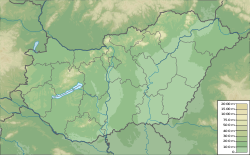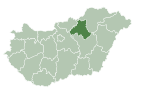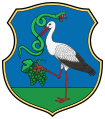Gyöngyös
Gyöngyös | |
|---|---|
 Orczy palace of Orczy family | |
| Coordinates: 47°47′00″N 19°56′00″E / 47.7833°N 19.9333°E | |
| Country | |
| County | Heves |
| District | Gyöngyös |
| Area | |
| • Total | 54.1 km2 (20.9 sq mi) |
| Population (2001) | |
| • Total | 33,553 |
| • Density | 620/km2 (1,600/sq mi) |
| Time zone | UTC+1 (CET) |
| • Summer (DST) | UTC+2 (CEST) |
| Postal code | 3200 |
| Area code | (+36) 37 |
| Website | www |
Gyöngyös [ˈɟøɲɟøʃ] is a town in Heves county in Hungary, 80 km (50 mi) east of Budapest. Situated at the foot of the Sár-hegy and Mátra mountains, it is the home of numerous food production plants, including milk production and sausage factories. It is also the home of many vineyards on the slopes of the Sárhegy.
The Art-Nouveau and Baroque buildings around the main square were reconstructed after a disastrous fire started in the local hospital in 1917,[1] destroying a number of buildings housing important Jewish institutions and leaving in all around 8,000 homeless.[2]
Name


The meaning of the town's name is "Made of Pearls"; Croats from Hungary call this city Đunđuš (pronounced as "Dyun-dyush"). The 16/17th-century historian Miklós Istvánffy wrote that the name of the town comes from the Hungarian word for mistletoe (fagyöngy literally "wood-pearl"), which is abundant in the local woods.
History
Gyöngyös was home to a large Jewish community before World War II. In 1942, anti-Jewish laws were adopted in the province, affecting the Jews of the town.[3] Following the occupation of Hungary by the German army in March 1944, 1800 Jews were locked in a ghetto. Some were saved by Hungarian Righteous Among the Nations personnel but most of them were deported to Auschwitz and killed.[4]
Sights to visit
There are many monuments and places of interest in the town, such as the Orczy mansion, home of the Mátra Museum, Saint Bartholomew's Church (Saint Bartholomew Church, Gyöngyös, Hungary) in the center of town, and its Treasury.
Notable residents
- Gyöngyi Horváth, sociologist, conference organiser
- Rudolph Ritter von Brudermann (1851–1941), general of Austria-Hungary during the First World War
- Béla Kerékjártó (1898–1946), mathematician
- Sandor Kenyeres (1949–), property developer, scientific philanthropist, and cultural visionary
- Gedeon Richter (1872–1944), pharmacist, business magnate, philanthropist, founder of Gedeon Richter plc, pioneer of the Hungarian pharmaceutical industry
- Soma Visontai (1854–?), lawyer, deputy
- Paul Vay de Vaya (1735–1800), Major General (1794), Feldmarschall-leutnant (1799–1800)
- Margit Gréczi (1941–), painter
- Zita Pataki (1973–), weather presenter
Politics
- Gábor Vona (1978–), politician, leader of the political party Jobbik
- Gábor Fodor (1962–), jurist, politician, leader of the Hungarian Liberal Party
- Pál Almásy (1818–1882), lawyer, politician, Speaker of the House of Representatives (1849)
- Károly Kamermayer (1829–1897), jurist, councillor, the first mayor of Budapest (1873–1896)
- József Balázs (1965–), politician
Gabor Horváth, (1963–) Brigadier General, Army Carrier Officer, promoter of NATO and EU membership,Commander
Sports
- Viktor Szabó (1986–), footballer
- Dárius Csillag (1995–), footballer
- Dávid Ficsór (1986–), footballer
- Gergő Gohér (1987–), footballer
- András Herczeg (1956–), football manager, former player, manager of Debreceni VSC
- Zsófia Kovács (1988–), professional triathlete
- József Éles (1969–), former handball player, handball coach of the Dominican Republic women's national team
- Attila Szekrényessy (1913–1995), pair skater
- Gabriella Csépe (1973–), former breaststroke swimmer
- László Polgár (1946–), chess teacher and educational psychologist
- Energia SC Gyöngyös (1992–), football club
International relations
Twin towns — Sister cities
Gyöngyös is twinned with:
 Pieksämäki, Finland
Pieksämäki, Finland Ringsted, Denmark
Ringsted, Denmark Sanok, Poland
Sanok, Poland Shusha, Azerbaijan[5] (de facto,
Shusha, Azerbaijan[5] (de facto,  Nagorno-Karabakh)
Nagorno-Karabakh) Târgu Secuiesc, Romania
Târgu Secuiesc, Romania Zeltweg, Austria
Zeltweg, Austria
Gallery
-
Aerial photograph of the water tower, built in 1927.
References
- ^ Charles Hebbert; Norm Longley; Dan Richardson (2002). Hungary (Rough Guide Travel Guides). Rough Guides Ltd. p. 323. ISBN 1-85828-917-3.
- ^ Adrian Phillips, Jo Scotchmer (2010). Bradt Travel Guides. Hungary. p. 222. ISBN 1-84162-285-0.
- ^ "Archived copy". Archived from the original on 2016-08-15. Retrieved 2016-05-26.
{{cite web}}: CS1 maint: archived copy as title (link) - ^ "המכון הבין-לאומי לחקר השואה – יד ושם". www.yadvashem.org.
- ^ "Archived copy". Archived from the original on 2013-08-05. Retrieved 2013-05-10.
{{cite web}}: CS1 maint: archived copy as title (link)
External links
- Official website in Hungarian and English
- Gyöngyös (in Hungarian) at gyongyos.info







